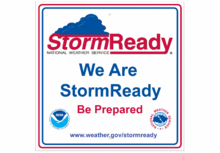On this page:
Wright State is StormReady
Wright State University - Dayton campus is the first institution of higher learning in the University System of Ohio to attain StormReady recognition from the National Weather Service and the Ohio StormReady Advisory Board.
We live in the most severe weather-prone country on Earth. Each year, Americans cope with an average of 10,000 thunderstorms, 5,000 floods, 1,000 tornadoes, and 2 landfalling deadly hurricanes. Severe weather includes winter storms, intense summer heat, high winds, wild fires and other deadly weather-related impacts. Approximately 90% of all presidentially declared disasters are weather related, leading to around 500 deaths per year and nearly $14 billion in damage.
StormReady began in 1999 to help communities validate their communication capabilities and safety skills needed to respond to severe weather. StormReady communities are better prepared through improved planning, education, and awareness programs. While no community is storm proof, being StormReady does help save lives. Read how being StormReady saved the lives of over 50 people at a movie theater in Van Wert, Ohio.
What does it mean to be StormReady?
There are six guidelines describing the requirements that must be met to qualify as a StormReady University. All StormReady communities must renew their designation every three years. Below is a description of the requirements met by Wright State University.
1. Communications & Coordination Center
Wright State has a "24-hour warning point" to receive National Weather Service information and provide local reports and advice. This operation is monitored by the University Police Service Center. Our 24-hour warning point:
- Operates 24/7/365.
- Receives warnings from the National Weather Service.
- Receives notification from the City of Fairborn when tornado warning sirens are activated.
- Activates the campus wide building notification system.
Wright State also has an Emergency Operations Center (EOC). Members of the EOC include senior administration, key decision makers, and the emergency management administrator. The University President or designee can activate the EOC based on established procedures including National Weather Service information or weather events. The EOC:
- Receives warnings from the National Weather Service.
- Assumes weather-related duties of the 24-hour warning point.
- Activates Wright State Alert! - Wright State's emergency notification system.
- Links with National Weather Service to relay real-time weather information to support the warning decision-making process.
2. National Weather Service Warning Reception
The University Police Service Center and EOC receive National Weather Service warnings from multiple sources that include:
- NOAA Weather Radio All Hazards radio with tone alert and Specific Area Message Encoding.
- Private sector web-based providers and direct internet access to National Weather Service information and warnings.
- Statewide law enforcement telecommunications.
- Local radio and television broadcasts.
3. Hydrometeorological Monitoring
In addition to the above sources of weather information, the University Police Service Center and EOC utilizes internet and mobile device access as a means of gathering ancillary weather information including high definition and doppler radar.
4. Warning Dissemination
The campus wide building notification system, tornado warning sirens, local radio and television overrides,NOAA Weather Radios, and the public address system on emergency vehicles may be utilized as a means of ensuring timely warnings to the University community.
- Outdoor tornado warning sirens at Wright State are controlled by our local jurisdiction having authority (City of Fairborn).
- NOAA Weather Radios are located in areas including the University Police Service Center EOC, campus housing community offices, Environmental Health and Safety, Physical Plant, and Nutter Center.
5. University Community Preparedness
Wright State recognizes the value of educating students, faculty, and staff about severe weather and how to respond properly to weather threats. Members of our University community are more likely to seek additional methods for receiving weather warnings, recognize potentially threatening weather situations, and act appropriately when severe weather strikes when they have participated in awareness programs. To that end, Wright State:
- Conducts presentations, safety talks, and weather-related preparedness campaigns.
- Publicizes and promotes NOAA Weather Radios.
- Promotes and encourages attending a National Weather Service SkyWarn weather spotter training class at least once every two years. Wright State - Dayton campus will host the SkyWarn spotter class each fall.
6. Administrative
Senior administration and key leadership at Wright State University support the requirements of the StormReady program. Written plans and procedures have been formally developed and are maintained to provide:
- An Emergency Action Plan.
- University Police Service Center standard operating procedures relating to severe weather.
- Standard operating procedures for activation of the EOC.
- Storm spotter activation criteria, reporting procedures, roster, and training record.
- Standard operating procedures for activation of Wright State Alert! - Wright State's emergency notification system.
- An annual exercise relating to a natural hazard.
To facilitate close working relationships, the Wright State University Emergency Management Administrator will visit the NWS Wilmington office at least every other year. Officials at NWS will visit Wright State University's Dayton campus to meet with Emergency and Risk Management staff and to tour the University Police Service Center and EOC.

